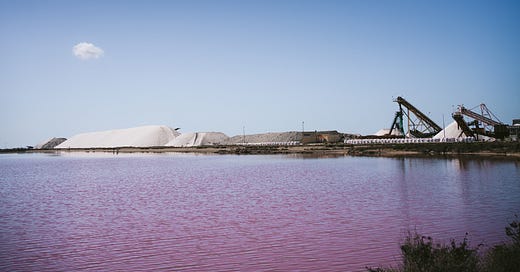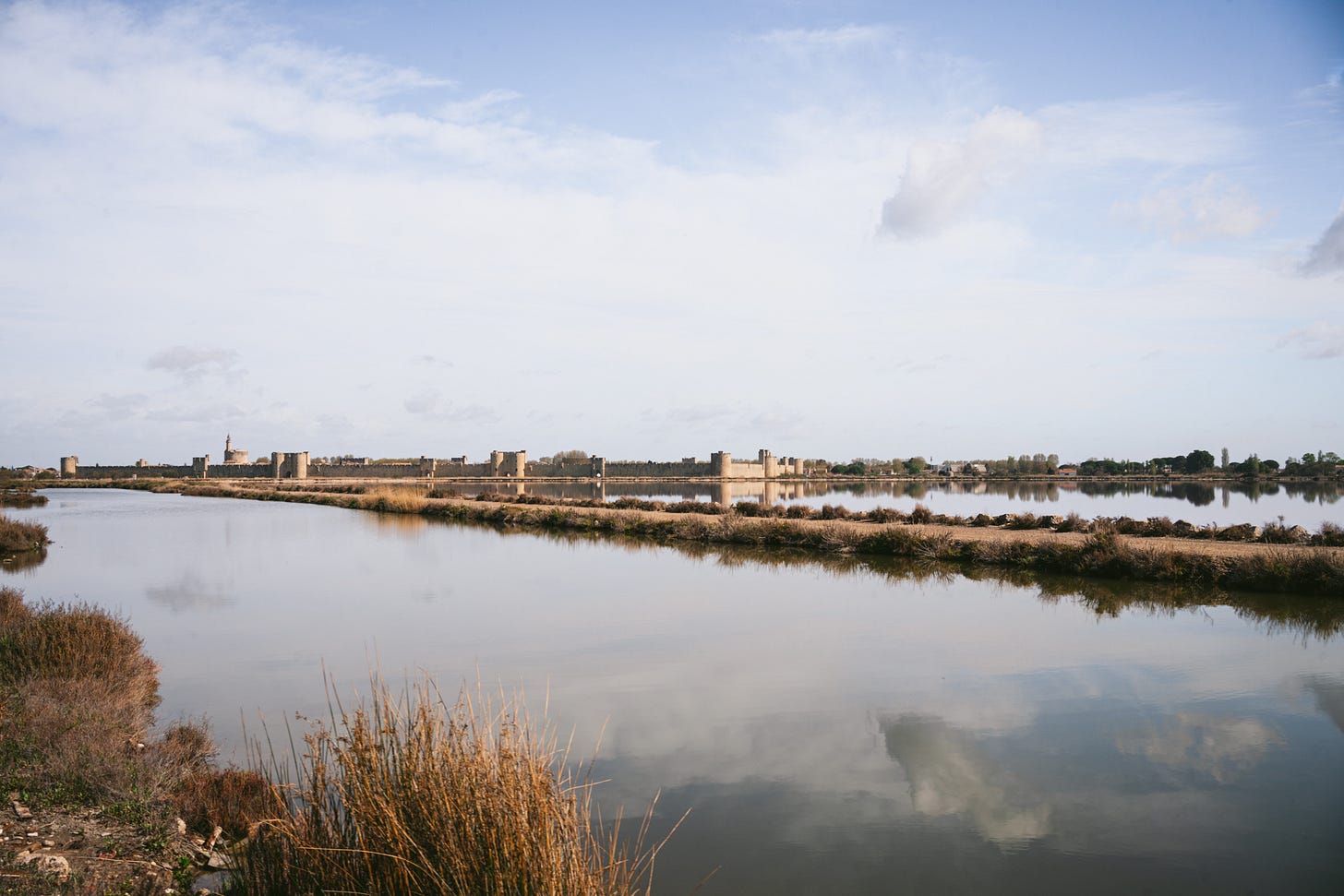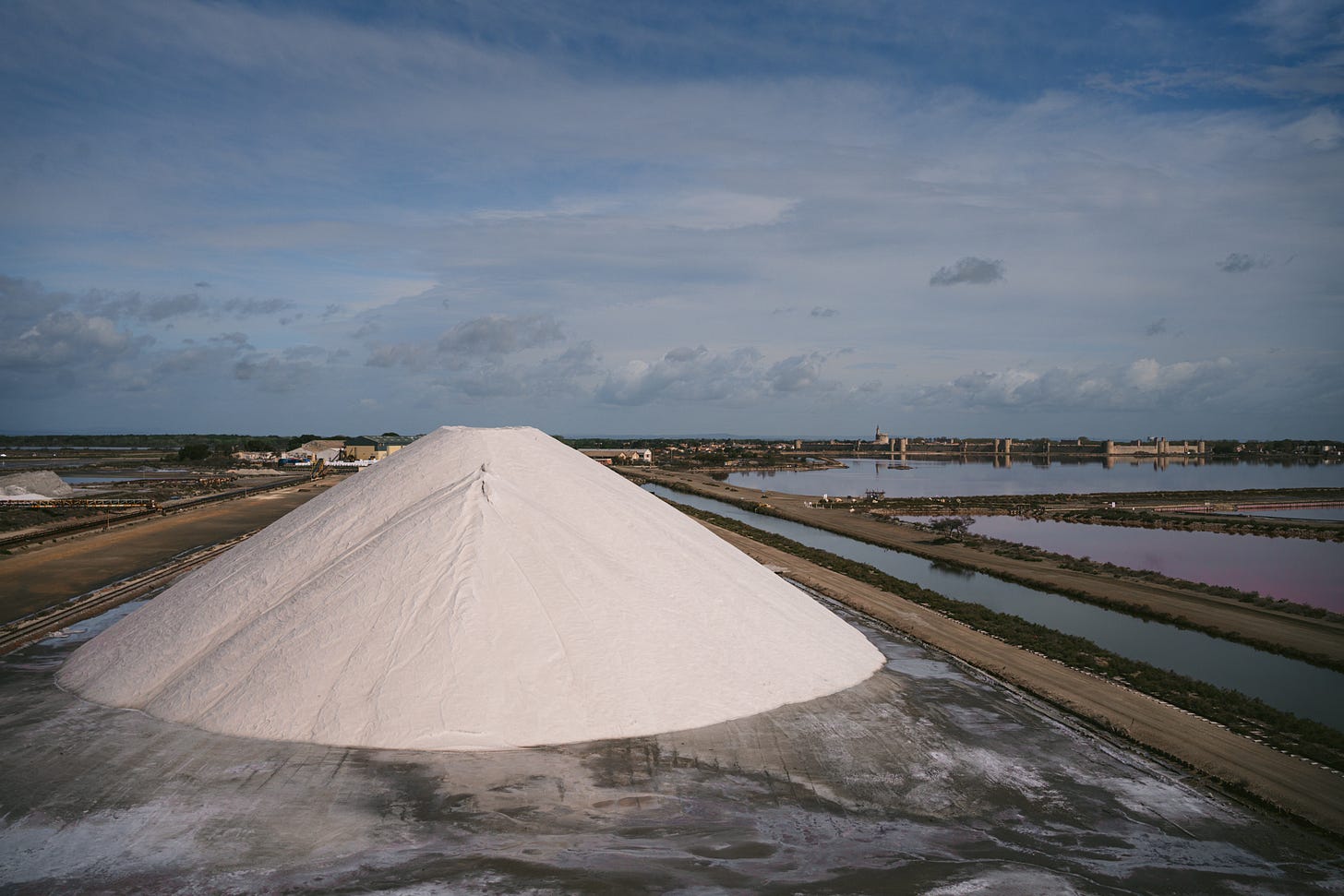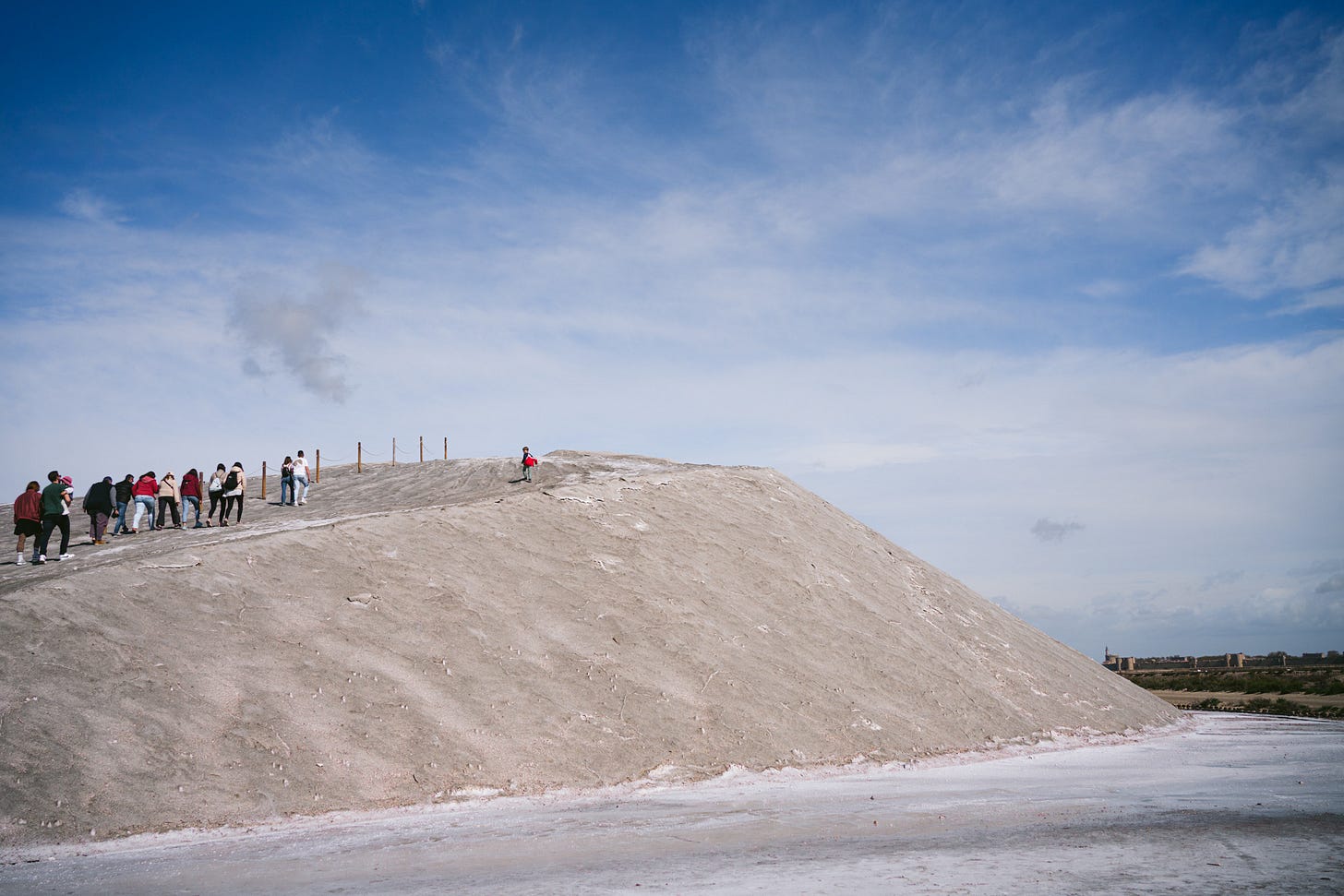Salt. Looking into an Ancient Salt Marsh in France
Tinted ponds that speak of power, struggle and revolution
Between Montpelier and Marseille, facing the Mediterranean Sea, you can find the vast wetland plane of the Camargue Regional Park. Situated in the Rhône delta, between the two main arms of the river, the region is a perfect cultivar for cornfields, asparagus fields, vineyards, and rice.
But aside agriculture, what dominates the landscape are the sansouires (salt flats), étangs (small salt water lakes) and marshlands, specially in the South tip of the park. From the walled medieval town of Aigues-Mortes (literally “dead waters”) my local friends Luz and Ben, my husband Ross and I drove 8 minutes to the entrance of the salt marsh. There we took a little train for an hour long tour where we not only saw pink died waters but flamingoes and literal mountains of salt.
The only rock we need to live
Salt is a simple thing, and as most simple things, it’s also very powerful, to the extend it keeps us alive. Primarily it’s a rock, a mineral composed of sodium chloride (NaCl), and it all comes from the ocean, even the ones we find in Himalayan mines.
It not only constitutes one of the basic tastes that humans can identify but sodium, as a nutrient, is essential for animals to generate nerve impulses and to maintain electrolyte and fluid balance in the body. For humans, the minimum physiological requirement for sodium is between 115 and 500 mg per day. And there’s also a recommended maximum, as an excess of it can cause hypertension:
Americans eat on average about 3,400 mg of sodium per day. However, the Dietary Guidelines for Americans recommends adults limit sodium intake to less than 2,300 mg per day—that’s equal to about 1 teaspoon of table salt! For children under age 14, recommended limits are even lower.
Most of the extra salt we consume nowadays is found in processed food. But humans have been using this rock for thousands of years. Our Palaeolithic ancestors used to get their intake of salt through the plants and specially meats they ingested; but time later, during the Neolithic era, people also discovered its preserving powers.
The only way to preserve food was with salt (or sugar) until very very recently in historical terms. With the spread of civilisation, the mineral became one of the world’s main trading commodities and was known as “white gold”. It is mentioned 23 times in the Bible and the expressions “covenant of salt” and “the salt of the earth” alluding to Christians spreading the word of God have been kept as popular sayings until this day.
Salt was part of funerals in Egypt as offering and as part of the preserving techniques for mummies. Salt was also used as a currency south of the Sahara, and slabs of rock salt were considered coins in ancient Abyssinia (current Ethiopia). Maybe that gave the idea to Romans to pay their wages in salt: salarium, from where we took the word salary. Salt was so precious that in those days a slave could be bought with a sheet of salt the length of his foot.
The Aigues-Mortes Salt marsh
It was the romans who developed the evaporation technique to harvest the salt in the saline and who created the salt marsh of the Camargue region. It extends through 8.000 hectares, which is equivalent of the size of central Paris and also makes it the biggest salt marsh of the Mediterranean.
As we went by with the train through paths connecting ponds side to side, we could only grasp the importance of the place. It is not only a relevant historical side but also a biodiversity treasure. The wetland is home of 200 different kinds of plants and a very important stop for migrating birds. The salt meadow creates a unique environment for many species to coexist making it the second most biodiverse landscape of the world after the tropical rainforest.
It was not its biodiversity what attracted king Louis IX to the area but its geographical relevance. After founding the town of Aigues-Mortes in 1246, the first French Mediterranean port city, the king had access not only to trade with Italy and Orient but also to the precious white gold. Indeed, the saltworks founded Saint Louis crusading in the Middle East and it was such a profitable means of generating revenue for the wars that the royal control of the salt marsh lead to the creation of the infamous salt tax gabelle.
On March 16, 1341, king Philip VI established the first permanent royal salt tax of the country. This obliged everybody above the age of 8 to buy a minimum amount of salt at a fixed price weekly which meant up to 7 kilograms (15lb) of salt per year. But different regions had different rates which created a perfect opportunity for smugglers that would buy salt in areas where it was sold cheaper and sell it illegally at inflated prices in regions where it was more expensive, but still less than the legal price.
The faux-sauniers (false salt men), which is the name the smugglers were known for, became local heroes while the gabelous, or custom guards, were despised. By the end of the eighteenth century, many of the smugglers were women, and even children, which in some areas made most of the arrests. It is believed one of the main reasons to the advent of the French Revolution (1789-1799) was the gabelle and other unfair taxes imposed upon the lower-classes and peasants. With the ascension of the National Assembly, the tax was voted down and abolished everywhere in France, and the financial prisoners were freed. Unfortunately time later, Napoleon Bonaparte thought otherwise and reinstated the gabelle in 1804. It was part of France’s legislation until 1946.
Camargue salt production hasn’t changed much since the Romans started it. It captures the essence of natural renewal energy: it only needs sea water, sun and wind to get to the precious crystals. And maybe some human ingenuity. Water circulates and evaporates during the months of March to September through a series of shallow ponds that constitute 3 quarters of the area of the marsh. The task of the salt workers is to maintain a constant depth of water, as moving from one pond of another, getting more and more concentrated, it loses 90% of the initial volume.
From the sea, 5 pumps take sea water, containing 29g salt/litre, at 45000 cubic meters/h. Which is equivalent of the water contained in 14 olympic swimming pools being poured every hour into the evaporation ponds. At first, that water has a blue-green tint, but as the months pass and the different ponds are filled, the color changes first to ocher, then to pink and finally to saturated red. As saturated as the water is salty because the last ponds are pure brine. The cause of the photograph-perfect tint is an algae called dunaliella salina.
This unicellular halophile algae is rich in carotene and is enjoyed by an inch-long tiny shrimp (artemia salina) that is also the dinner of iconic pink flamingoes. Pink because the shrimp is so and basically because the algae is so. But when water becomes too salty, the shrimp disappears and the algae proliferates tinting the waters for our pleasure and as a visual cue for workers to know the level of salt concentration.
At the end of the summer, saturated brine is brought to the crystallising ponds. When the water reaches a 25% salinity the salt begins to crystallize and it’s ready to be harvested. So in September the salt crust is lifted off and stored in bulk in a huge pile called the camelle. Then, it’s washed, drained, packed and shipped off as fleur de sel.
The harvest can be up to 200.000 tones of salt per year so you could imagine the amount stored would make a hill. And it does. From the top of the camelle there’s exquisite views of the various salt ponds, all colored in different shades, and of the Medieval fortified city that was one of the most important ports for France until Marseille took its place.
From there you can also understand the importance of the area: not only for its biodiversity but also for the implications it had for this country. The salt below our feet financed the Crusades, squeezed the pockets of citizens to the point of uprising with the chant Liberté, Égalité, Fraternité which created a world precedent for people speaking out for their rights and shaped the Modern Era. It also gave a salty crunch to the top of steaks and caramel cakes, which is not as relevant but to some, it makes a difference.
Further reading:
Le Saunier de Camargue. Visit the Aigues-Mortes salt marshes
La sal. An essay I wrote about salt and my visit to a salt harvest in Bali (in Spanish)
Weller, Olivier; Brigand, Robin; Nuninger, Laure (June 2008). Spatial Analysis of Salt Springs Exploitation in Moldavian Pre-Carpatic Prehistory (Romania). Archædyn.















This is so fascinating. I had no idea sugar was a preservative. Since salt is in everything, it's nice to have a deeper understanding of it's history.